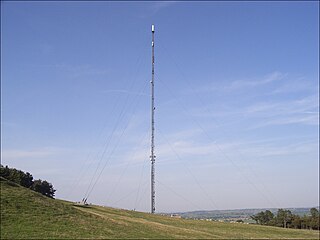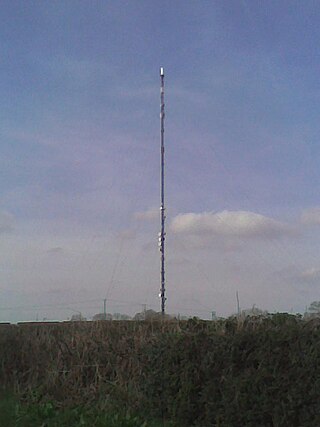
The Crystal Palace transmitting station, officially known as Arqiva Crystal Palace, is a broadcasting and telecommunications site in the Crystal Palace area of the London Borough of Bromley, England. It is located on the site of the former television station and transmitter operated by John Logie Baird from 1933.
The Sutton Coldfield transmitting station is a broadcasting and telecommunications facility located in Sutton Coldfield, Birmingham, England. In terms of population covered, it is the third most important transmitter in the UK, after Crystal Palace in London and Winter Hill near Bolton.

The Mendip transmitting station is a broadcasting and telecommunications facility on the summit of Pen Hill, part of the Mendip Hills range in Somerset, England, at 305 metres (1,001 ft) above sea level. The station is in St Cuthbert Out civil parish, approximately 2 miles (3.2 km) north-east of Wells. Its mast, 293 m (961 ft) high, was built in 1967 and is the tallest structure in South West England. The mast broadcasts digital television, FM analogue radio and DAB digital radio, and had broadcast analogue colour television from 1967 until 2010.

The Moel-y-Parc transmitting station is situated on Moel y Parc, a hill in north-east Wales at the northern end of the Clwydian range, close to the town of Caerwys and several miles (kilometres) north-east of Denbigh. It was built in 1962/1963 by the ITA to bring 405-line VHF ITV television to North Wales and it has been on the air since 1963. Its original height of 229 metres (751 ft) made it the tallest structure in North Wales and it stands on land that is itself about 335 metres (1,099 ft) above sea level. In 1965, VHF television transmissions from the BBC commenced from the site.
The Llanddona transmitting station is a broadcasting and telecommunications facility, situated at Llanddona, near Beaumaris, on the isle of Anglesey, Wales. It comprises a 106.7 metres (350 ft) guyed mast with antennas attached at various heights. It is owned and operated by Arqiva.

The Wenvoe transmitting station, officially known as Arqiva Wenvoe, is the main facility for broadcasting and telecommunications for South Wales and the West Country. It is situated close to the village of Wenvoe in the Vale of Glamorgan, Wales, in the UK.

The Preseli transmitting station is a broadcasting and telecommunications facility on the eastern end of the Preseli Mountains, close to the villages of Crymych and Pentre Galar in Pembrokeshire, Wales. It is owned and operated by Arqiva.
The Oxford transmitting station is a broadcasting and telecommunications facility, situated on land 129.5 metres (425 ft) above Ordnance Datum to the north east of the city of Oxford, in Oxfordshire, England. It has a guyed steel lattice mast which is 154.4 metres (507 ft) in height to the top of the main steel structure. The UHF television antenna, which consist of a vertical array of transmitting panels, is mounted above the steel structure. The total height of the mast to the top of this UHF antenna is 165.7 metres (544 ft). It is owned and operated by Arqiva.

The Stockland Hill transmitting station is a transmitting facility of FM Radio and UHF television located near Honiton, Devon, England.

The Carmel transmitting station, located half a mile (0.8km) SSW of the village of Carmel in Carmarthenshire, has been broadcasting terrestrial TV and radio services since the mid-1970s. The TV coverage area for the Carmel transmission station includes most of Carmarthenshire, the southern and eastern parts of Pembrokeshire; the southern fringes of Powys and Ceredigion; the northern part of Swansea. The Carmel signal is also receivable in parts of Neath Port Talbot, Bridgend and Rhondda Cynon Taff. Places as far away as Merthyr Tydfil and the north Devon coast are also able to receive signals from Carmel.
The Brecon transmitting station was originally built by the IBA in 1970 as a relay for VHF 405-line analogue television: one of the last 405-line TV stations to be built in Britain. As built, it consisted of a 46 m guyed lattice mast carrying the aerials at the top. This structure was built about 300 m NW of Slwch Tump Iron Age hill fort on the slopes of a 240 m hill known as "The Slwch" overlooking the town. The VHF television feed was provided off-air from Abergavenny, about 25 km to the southeast - itself an off-air relay of St. Hilary near Cardiff.
The Alltwen television relay station is sited on a hill to the southwest of Pontardawe in the Swansea Valley, at least a kilometre away from the village of Alltwen from which it takes its name. It was originally built in the late 1980s as a fill-in relay for UHF analogue colour television. It consists of a 17 m self-supporting lattice mast standing on Craig Glyn Meirch, a hillside which is itself about 140 m above sea level. The transmitters are beamed northwards and eastwards to cater for those digital terrestrial TV subscribers in the towns of Pontardawe and Alltwen who for reasons of geography can't get a signal from the much bigger and more powerful Pontardawe transmitter. The Alltwen transmission station is owned and operated by Arqiva.
The Mynydd Emroch television relay station is sited on the eponymous hill to the east of Port Talbot. It was originally built in the 1970s as a fill-in relay for UHF analogue television. It consists of a 25 metres (82 ft) self-supporting lattice tower standing on a hillside which is itself 600 ft above sea level. The transmitters are beamed southwards to cater for those digital terrestrial TV subscribers in Port Talbot and Margam which for reasons of geography can't get a signal from the Kilvey Hill transmitter across the bay at Swansea. The Mynydd Emroch transmission station is owned and operated by Arqiva.
Cilfrew television relay station is sited on a hill south of the village of Tonna, at least 2 km across the valley from Cilfrew in the Neath Valley. It was originally built in 1981 as a fill-in relay for UHF analogue colour television serving the villages of Cilfrew itself, Aberdulais and Tonna. It consists of a 30 m self-supporting lattice mast standing on land which is itself about 80 m above sea level. The transmissions are beamed to the north. The Cilfrew transmission station is owned and operated by Arqiva.
The Efail Fach television relay station is sited on a hill west of the villages of Efail Fach, Cwm Pelenna and Tonmawr. It was originally built in the 1980s as a fill-in relay for UHF analogue colour television serving all of those settlements. It consists of a 15 m self-supporting lattice mast standing on a hill which is itself about 160 m above sea level. The transmissions are beamed to the east towards the Pelenna valley. The Efail Fach transmission station is owned and operated by Arqiva.
The Neath Abbey television relay station is sited on a hill north of the town of Neath. It was originally built in the 1980s as a fill-in relay for UHF analogue television serving the parts of the town of Neath to its east with its vertically polarised signal, and the parts of the town to its northwest with its horizontally polarised signal. This is an unusual layout, chosen to avoid signal degradation from reflections off the cliffs to the north. The site consists of a 12 m self-supporting lattice mast standing on land which is itself about 80 m above sea level. The Neath Abbey transmission station is owned and operated by Arqiva.
The Midhurst transmitting station is a facility for both analogue and digital VHF/FM radio and UHF television transmission, 3.1 miles (5.0 km) northeast of Midhurst, West Sussex, England. The station broadcasts to much of the northern half of West Sussex, and to small parts of Surrey and Hampshire. This includes towns such as Horsham, Midhurst, Haslemere, Godalming, Petersfield, Steyning, and Bordon.
The Abergavenny transmitting station was originally built by the IBA in 1969 as a relay for BBC and ITV VHF 405-line analogue television. It consists of a 46 m guyed lattice mast carrying the aerials at the top. This structure was built on a 440 m hill known as Gilwern Hill overlooking the towns of Gilwern and Abergavenny in Monmouthshire, South Wales. The band III VHF television feeds were provided off-air from St. Hilary and Wenvoe, both near Cardiff.
The Llanidloes transmitting station is a broadcasting and telecommunications facility consisting of a self-supporting 23 m lattice mast erected on land that is itself about 245 m above sea level about 1 km to the west of the town of Llanidloes in Powys, Wales. It was originally built by the BBC, entering service just before Christmas 1966 transmitting the now-defunct 405-line VHF television system. Transmissions of the original three FM radio services began in February 1967.
The Rosemarkie transmitting station is a broadcasting and telecommunications facility, situated close to the town of Rosemarkie, Scotland, in Highland. It consists of a 110 metres (361 ft) high guyed steel lattice mast erected on land that is itself about 210 m above sea level only a few hundred metres from the coast of the Moray Firth. It is owned and operated by Arqiva.








